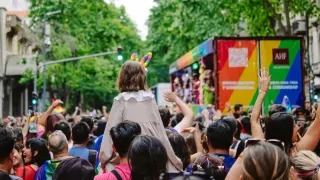
Nov 5
Reece Walsh’s Nail Polish Rebellion: When Rugby’s Locker Room Meets Queer Defiance
READ TIME: 3 MIN.
Let’s paint a picture: Hill Dickinson Stadium, Liverpool, the air thick with adrenaline and anticipation. The Brisbane Broncos’ Reece Walsh, a 23-year-old rugby prodigy with a penchant for bold choices, is temporarily off the pitch. But it isn’t a missed tackle or a dropped ball that draws the crowd’s ire—it’s his nails. Yes, his nails. Sporting a glossy coat of nail polish, Walsh finds himself the target of “horrendous” homophobic abuse, with fans launching “vile insults no player should have to endure” according to reporters on the scene .
The crowd zeroes in on Walsh’s nail polish, hurling slurs and mocking his choice. Walsh—straight, Indigenous Australian, and Māori—doesn’t shrink. Instead, he turns the moment on its head, responding with a cheeky quip: “Are you still a virgin?” . The stadium erupts in mixed reactions, but for LGBTQ+ viewers—and anyone who’s ever felt the sting of conformity—this was a moment that glittered with resistance.
Walsh’s nails aren’t just a fashion statement; they’re a line in the turf where sport’s rigid gender codes meet the audacity of self-expression. In rugby, a sport where toughness is currency and vulnerability is often taboo, painted nails disrupt the narrative. The backlash Walsh faced is depressingly familiar to queer athletes and fans, echoing the kind of policing that LGBTQ+ communities know all too well—where gender is policed, and anything outside the ‘norm’ is met with ridicule or hostility .
But Walsh’s refusal to back down—his choice to show up with painted nails, then clap back at homophobia with humor—embodies the kind of allyship and visibility that moves the needle. It’s a reminder: visibility, even with something as simple as nail polish, can challenge centuries-old stereotypes and open space for everyone, regardless of how they identify.
For LGBTQ+ audiences, nail polish is loaded with history. From drag queens to trans femmes, from pop stars like Lil Nas X to everyday folks carving out space in hostile environments, painted nails have long signaled queerness, rebellion, and self-love. Walsh’s act—intentional or not—puts queer-coded self-expression center stage in a hyper-masculine arena where diversity is often sidelined .
Consider the ripple effect: LGBTQ+ youth watching rugby see a star player sporting nail polish, refusing to apologize, and shutting down hate. It’s a punchline that lands like a rallying cry, especially in a year where queer rights in sports remain fiercely contested. And it’s not the first time Walsh’s nails have made headlines—last year, he posted a photo of pink nails on Instagram, prompting a wave of online abuse, but also a flood of supportive comments .
Let’s be clear: the abuse Walsh faced was ugly, and it shines a spotlight on how far sports culture still has to go. But his response—smile, nail polish gleaming, retort ready—is a model for how to face down hate. For queer fans, it’s a reminder that visibility matters, and that allyship isn’t just about rainbow hashtags—it’s about showing up, making choices, and refusing to let bullies dictate the rules.
Walsh’s Indigenous heritage adds another layer: his presence and defiance connect threads of intersectionality, showing how sport can be a battleground for not just queer rights, but for race, culture, and the right to simply be. As rugby continues to grapple with its own history of exclusion, moments like these are a clarion call to open the doors wider, to make room for every kind of athlete—and fan.
Australia won the game 14-4, but the real victory belonged to anyone who’s ever felt unsafe for defying gender norms. Painted nails, a cheeky comeback, and a refusal to step back: it’s the kind of win that transcends scoreboards .
For the LGBTQ+ community, the stakes aren’t just about sports—they’re about dignity, safety, and the freedom to express. Reece Walsh’s nails are more than a style choice: they’re a small act of rebellion with big implications. In a world that still tries to police bodies and identities, every brushstroke of color is a step towards belonging.
So next time someone asks why nail polish matters in rugby, remember this moment: a young star, a stadium full of noise, and the choice to be visible. For queer sports fans, it’s hope with a side of glitter—and a reminder that the game is always bigger than the field.






